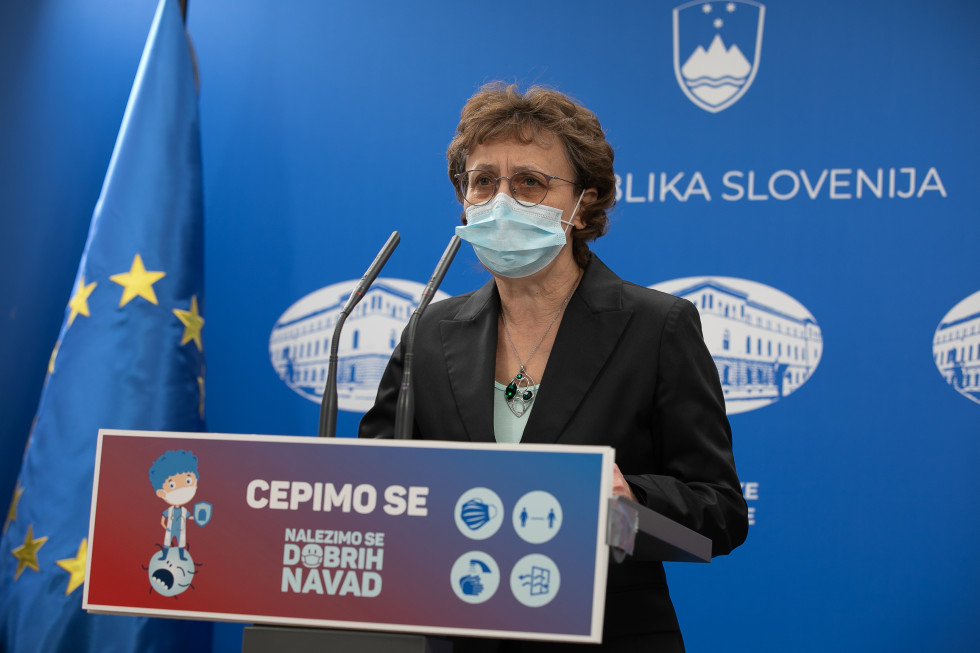By: UKOM
The Friday press conference on the current COVID-19 situation was attended by the deputy head of the Communicable Disease Centre at the National Institute of Public Health, Nuška Čakš Jager, who presented the current situation on COVID-19 cases in the world, Europe and Slovenia.
According to Thursday’s data, 11,668 cases were confirmed in Slovenia after 3,808 PCR tests and 103,514 rapid antigen tests were performed. Currently, there are 194,969 active cases. The number of confirmed cases per 100,000 inhabitants in the last 14 days is 9,251, which is well above the European average. The seven-day average of confirmed cases stands at 14,381. Ms Čakš Jager noted that most infections are local cases and that there are almost no imported cases. According to the surveys, the majority of respondents marked the location of infection as unknown. She added that there has been an increase in the number of cases in homes for the elderly, whereby most patients are completely asymptomatic, with the infections confirmed only due to testing. The number or deaths has significantly decreased compared to the previous waves of the epidemic.
According to the latest data, 70% of the Slovenian population aged 18 and over has received one dose of vaccine, while 68% of Slovenians aged 18 and over have been fully vaccinated.
Global epidemiological data show a rise in the number of COVID-19 cases, especially in Europe, though only marginally. Elsewhere in the world, the number of cases has mostly been decreasing, but there has been an increase in the number of deaths due to COVID-19 particularly in the Americas and Asia.
Based on the WHO report, the Omicron variant has become predominant. It should be noted that 57 countries reported an accelerating increase in cases of the Omicron BA.2 sub-variant, which is already ubiquitous. The worldwide prevalence of Omicron is at 90%, although the Delta variant is also still present.
According to yesterday’s data, from 31 December 2019 to 30 January 2022, there were 86,814,227 people suffering from COVID-19 in the EU, with 957,489 of them having died. The number of confirmed cases per 100,000 EU citizens in the last 14 days is 3,605. More and more countries are seeing a decline in the number of COVID-19 cases, with Italy, Spain, Ireland and Belgium at the forefront of this negative trend. Omicron’s prevalence is at 83.4%. In the EU, 81.7% of the population aged 18 years and over have been fully vaccinated, and 54.8% of EU citizens have received the third booster dose.
According to the risk assessment data as at 19 January 2022 prepared by the European Centre for Disease Prevention and Control (ECDC), the number of new cases and the number of deaths in the EU are stable. However, the ECDC increased the number of countries identified as very high-risk countries to 13 and among them is Slovenia. Fourteen countries have been identified as high-risk and three as medium-risk countries. In comparison to the previous weeks, the prevalence among people of the age group over 50 years has increased.
According to the ECDC, the course of the disease after Omicron infection is less severe and fewer hospitalisations are needed. Studies also show that vaccination protects against a more severe course of the disease, with a third, booster, dose being very important. On the other hand, the protection after vaccination and recovery is slightly lower, making a large percentage of the population susceptible to infection.
It should be noted that the 14-day incidence of Omicron infection cases is four times higher than the 14-day incidence at the time of the Delta-dominated infections, while the rate of hospitalisations and deaths is much lower than in the case of infections with the Delta variant. The ECDC does not yet dispose of any data on post-COVID symptoms after infection with the Omicron variant; however, due to the high number of Omicron infections, more post-COVID health problems can be expected.
The infection rate among the elderly is increasing and so is the number of time-delayed hospitalisations. The rapid increase in the number of Omicron infections in the European Union is placing an enormous burden on the healthcare system, which is even greater in countries with lower vaccination rates, i.e. below 75% as defined by ECDC.
The current situation in Europe shows an extremely rapid transmission of infections, in particular within households, a high pressure on the healthcare system, with an alarming absence of healthcare workers due to the high prevalence within the healthcare system, and a reduced functionality of society at all levels critical for the functioning of society.
The deputy head of the Communicable Disease Centre at the National Institute of Public Health, Ms Čakš Jager, reiterated the ECDC’s recommendations to prevent the spread of COVID-19 infections, which in the first place include vaccination to prevent severe infections and self-protective behaviour, which means using masks, keeping distance, regular hand hygiene and disinfection, ventilating indoor areas and working from home where possible, testing and contact tracing in the event of an infection, and strict adherence to isolation rules (infected persons) or quarantine (high-risk contacts).
Source: gov.si

